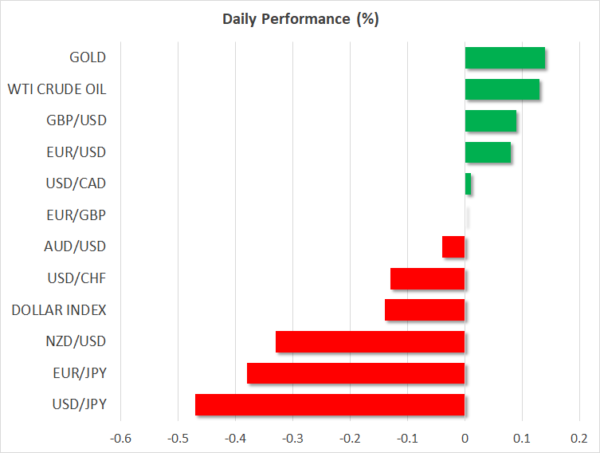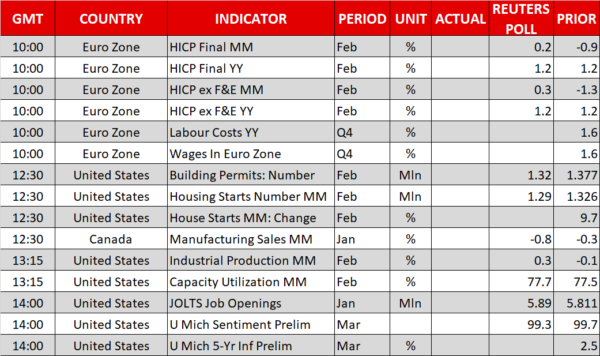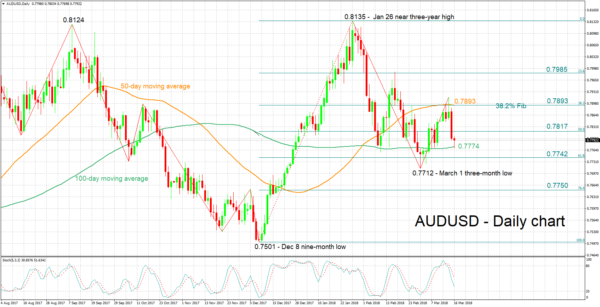Here are the latest developments in global markets:
FOREX: The dollar traded lower against a basket of currencies on Wednesday on the back of reports suggesting that the White House personnel shakeup would continue. The safe-haven perceived yen was the biggest beneficiary from these reports.
STOCKS: US markets ended mixed yesterday, as political uncertainty and protectionist concerns continued to suppress risk appetite. Reportedly, Special Counsel Robert Mueller ordered the Trump organization to hand over documents related to the Russian investigation, while separate reports suggest the President is set to sack his national security advisor next. The Dow Jones climbed by 0.5%, while the S&P 500 and the Nasdaq Composite fell by 0.1% and 0.2% respectively. Moreover, futures tracking the Dow, S&P and Nasdaq 100 are all currently flashing red. The risk aversion rolled into Asian trading, with Japan’s Nikkei 225 and Topix tumbling by 0.6% and 0.4% correspondingly, while Hong Kong’s Hang Seng index was down by 0.3%. In Europe, futures tracking all major benchmarks are in negative territory, pointing to a slightly lower open.
COMMODITIES: In energy markets, both WTI crude and Brent are higher by 0.1% today, ahead of the Baker Hughes oil rig count data at 1700 GMT. Rigs fell in the previous week, and it will be interesting to see if the pattern continues. If so, it would enhance the narrative that US production may have peaked for now, easing some of the downward pressure on oil prices. In precious metals, gold is up by 0.15% today, recovering some of the notable losses it posted yesterday on the back of a stronger US dollar. The yellow metal has remained largely indifferent to the recent risk aversion, in contrast to other safe-haven assets such as the Japanese yen or US Treasuries, which have experienced a notable surge in demand.
Major movers: Yen on the rise on seeming lack of stability in the White House
Reports that US President Donald Trump plans to oust his national security adviser H.R. McMaster weighed on the dollar. Those reports were later refuted by the White House, but still, given they add to the narrative that things are not working smoothly in the administration, they continued to act to the detriment of the US currency. The dollar index was down by 0.1% at 0730 GMT. Falling long-term Treasury yields were also seen as contributing to the decline in the dollar.
The yen, which tends to benefit at times of uncertainty, was on the rise on the back of US political developments. Dollar/yen traded 0.45% lower at 105.85. A political scandal has been hitting headlines earlier in the week in Japan, mounting pressure on the country’s Finance Minister to resign. Japanese press is currently reporting the Finance Minister will not be attending the highly-anticipated G20 meeting next week, which serves as a testament to the seriousness of the situation. Weekend poll results on the approval rating of Prime Minister Shinzo Abe – who has been promoting a weak yen policy – will be attracting interest in this respect. Euro/yen was also facing pressure, being down by 0.4% at 130.35.
Euro/dollar traded higher by 0.1% at 1.2319 after shedding 0.5% on Thursday. Dovish-perceived comments by ECB chief Mario Draghi didn’t allow the currency to advance versus the dollar this week. It is notable that euro/pound recorded a more than two-week low of 0.8821 on Thursday. Today the pair is flat, trading not far above the aforementioned low.
Pound/dollar was 0.1% up at 1.3950, with developments on Brexit expected to offer direction to the pair moving forward.
In commodity-linked currencies, dollar/loonie was roughly flat after surging 0.8% on Thursday. Soft housing data out of Canada led market participants to revise their tightening expectations for the Bank of Canada, pushing additional rate hikes back in time, while some comments by President Trump spurred trade worries and also hurt the Canadian dollar. Despite currently being flat, dollar/loonie recorded a near nine-month high of 1.3071 earlier on Friday. The aussie and the kiwi were down by 0.05% and 0.3% versus their US counterpart on falling risk sentiment. Aussie/dollar and kiwi/dollar touched 0.7768 and 0.7239 earlier on Friday, their lowest since March 6.
Day ahead: Eurozone & US data due with political uncertainties in the spotlight
In the eurozone, the most noteworthy release will be wage growth figures for Q4 at 1000 GMT, though no forecast is available. Faster wages are critical for inflation to move higher and thus, these prints will be watched closely by ECB policymakers and investors alike. A potential acceleration in wages could spark speculation that inflation may pick up soon and that the ECB could adopt a more hawkish stance at its upcoming meetings, thereby helping the euro to recover some of its latest losses. Conversely, if wages grow at the same pace as previously or slow down, the common currency may continue to correct lower. Eurozone’s final CPI data for February are also due out at 1000 GMT, but the final figures are usually not a major market mover.
In the US, industrial production data for February will be released at 1315 GMT and expectations are for production to have risen by 0.3%, a rebound following a 0.1% tumble previously. Besides this, there’s a raft of second-tier indicators due out. Building permits and housing starts for February will be made public a little earlier, at 1230 GMT. A few hours later, at 1400 GMT, the preliminary University of Michigan consumer sentiment index for March and the Job Openings and Labor Turnover Survey (JOLTS) for January will be in focus.
In equity markets, the spotlight remains on political developments, particularly those surrounding protectionism. Note that yesterday, White House trade adviser Peter Navarro said that in the coming weeks, President Trump will get recommendations on how to address China’s “theft” of American intellectual property. He added that this will be only one of many steps that the administration will take to tackle unfair trade practices, intensifying speculation that the situation could quickly escalate into a tit-for-tat trade war.
In the oil market, the Baker Hughes oil rig count is due for release at 1700 GMT. The number of active US rigs fell last week, providing an indication that US production may have peaked for the time being, or is slowing down at least. Another decline in rigs today could add credibility to that argument and thereby, ease some of the downward pressure on oil prices in the near-term. Even if that is the case though, it’s worth noting that agencies like the EIA anticipate US production to surge much further by the end of the year, so any slowdown in US supply may prove to be only a temporary phenomenon.
In politics, attention is likely to remain on the chaos in US politics, and specifically on whether President Trump will indeed fire his national security advisor H.R. McMaster. If he does, this would mark the third departure of a key figure from the administration in the span of a few days, something widely seen as increasing the probability for more protectionism, as the more moderate voices are “leaving the building”.
Technical Analysis: AUDUSD posts 12-day low; bearish signal by stochastics in very short-term
AUDUSD has recorded a 12-day low of 0.7768 earlier on Friday after losing roughly 1.0% on the day that preceded. The stochastics are giving a bearish picture in the very short-term for the pair: the %K line has crossed below the low %D one – while both lines were above 80 – and the two lines are currently heading lower. Australia is a major commodity exporter and its currency tends to benefit on upbeat views on the global economy.
Escalating trade tensions weighing on the outlook for global growth could hurt the pair. At the moment, support could be occurring around the 100-day moving average at 0.7774 which was briefly violated earlier on Friday. A downside violation would bring into view the 61.8% Fibonacci retracement level of the December 8 to January 26 upleg at 0.7742 for additional support.
Receding fears for a trade war on the other hand are expected to boost risk appetite and likely support AUDUSD. Resistance in this case could come around the 50% Fibonacci level at 0.7817 and further above – in case of stronger bullish movement – at the 38.2% Fibonacci mark and the 50-day MA which coincide at 0.7893.















